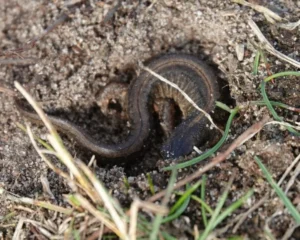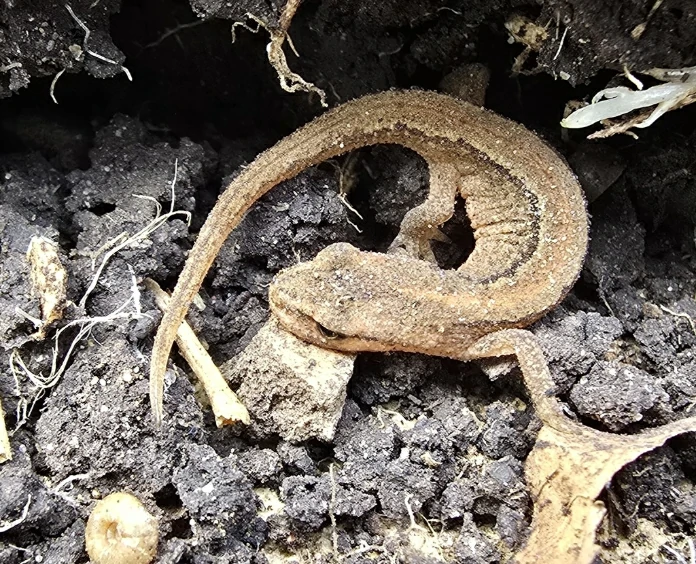You’re wandering through a damp forest after a gentle rain when you see a newt moving slowly across the leaf litter. It pauses, then slips into a shallow spot in the soil. You stop and wonder: did it just dig its own hiding place?
Yes, newts can dig, but not like moles or other animals built for burrowing. They use their small limbs and heads to push aside soil, leaves, or soft ground. By doing this, they make shallow burrows or hiding spots that help them stay safe, keep moist, and rest when conditions are tough.
It’s one of those quiet little habits that shows how adaptable these secretive amphibians really are.
Why Do Newts Dig?
Newts have soft, delicate skin that needs moisture, so digging is an easy way to protect themselves.
By digging, they can:
-
Hide from predators under soil, leaves, or moss
-
Escape heat, dryness, or cold weather
-
Rest in a safe spot during the day when they’re less active

A newt may look slow or clumsy, but when it digs, it’s patient and steady. ]Each push of its tiny limbs moves just enough debris to slip underneath and vanish.
How Do Newts Dig?
Newts don’t have claws like moles, but they still manage.
They use:
-
Their front limbs to scrape or push soil and leaves
-
Their heads to nudge material aside
-
Their long bodies to squeeze into the loosened space
When a newt digs, it’s not trying to make a tunnel. It’s simply shaping a shallow pocket just big enough to curl up in.
A few minutes of work is usually all it takes.
Shallow Burrows vs. Deep Tunnels
Most burrows made by newts are shallow, only a few centimeters down under leaves, moss, or soft soil. These shallow digs help them:
-
Stay moist
-
Avoid being spotted by predators
-
Rest quietly during hot daylight hours
Deep tunnels are rare. Sometimes newts use cracks in soil, gaps under rocks, or abandoned burrows left by other animals.

But creating deep tunnels themselves is beyond what they can do.
Digging to Escape Heat or Cold
Temperature is a big reason newts dig. On hot days, the surface dries quickly, so a newt may go a few centimeters down to find cool, damp soil.
In colder months, digging into the ground helps protect them from frost.
Soil acts like a blanket, keeping the space below more stable.
Even in winter, a shallow burrow can keep a newt alive until spring.
So digging isn’t just about hiding, it’s also a smart way to handle extreme weather.
When Do Newts Dig Most?
Newts are most active at night or in the early hours of morning and evening. Digging usually happens:
-
During the day, when predators are out
-
When the soil is soft and moist
-
Before harsh weather, like very hot days or cold nights
Young newts dig more often than adults. Because they’re smaller and easier prey, digging gives them extra safety.
Adults may use thick plants or logs for cover, but they’ll still dig when needed.
Do All Newts Dig the Same Way?
Different species use slightly different methods.
For example:
-
Eastern Newts often dig small hollows under moss near water
-
Smooth Newts in Europe may burrow under soft leaf litter in forests
-
Fire-Bellied Newts in Asia sometimes push aside debris along pond edges

No matter the species, the reason is the same: protection, moisture, and a good place to rest.
Digging vs. Natural Hiding Spots
You might ask why they bother digging at all when plenty of natural hiding spots exist. The answer is control.
By digging, newts make a shelter that fits their body perfectly, in the exact spot they choose.
Natural spaces like logs or moss may already be taken, or too exposed. Digging gives them a reliable pocket made just for them.
Digging During Mating Season
Digging even plays a role in breeding time. Some newts make shallow hollows near water where they can hide while waiting for mates.
These aren’t nests, but they provide safety while newts move between land and pond.
Even a small burrow lowers stress and gives them cover during this busy season.
Can Digging Be Risky?
Yes, there are risks. For example:
-
Dry soil can scratch or harm their delicate skin
-
Disturbed leaf litter may reveal their location to predators
-
Heavy rain can flood shallow burrows, forcing them out quickly
Still, digging is usually safe and helpful. For newts, it’s a quiet, simple way to stay alive.
Watching Newts Dig in Captivity
Pet owners sometimes notice digging in tanks. A newt might push aside soil, gravel, or leaves to make its own resting spot.

This is completely normal and healthy.
That’s why it’s important to provide soft, moist substrate in captivity. Without it, newts can’t express their natural digging behavior and may become stressed.
Conclusion
So, can newts dig? Yes, they can. Not like animals with claws and big tunnels, but in their own simple way.
By pushing soil, leaves, or moss aside, they make safe, moist spots to rest and survive.
Digging may not look impressive, but it’s very useful.
It keeps them hidden, helps them handle heat and cold, and gives them control over their little corner of the forest floor.
When you see a shallow depression in damp soil or moss, you might just be looking at a newt’s quiet hiding place.
For such a small creature, this little skill makes all the difference.
Hi, my name is Ezra Mushala, i have been interested animals all my life. I am the main author and editor here at snakeinformer.com.

